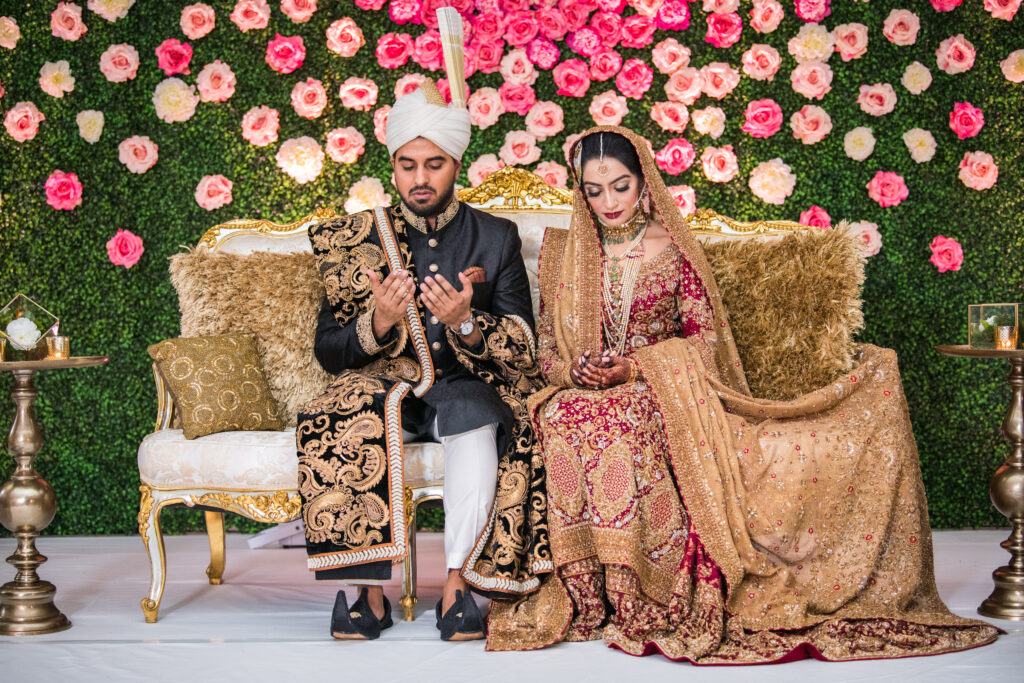
Muslim wedding traditions among Indians, Pakistanis and the South Asian muslim diaspora are celebrated differently than in Middle Eastern culture.
Just like all muslims, South Asian muslims hold the seriousness of the wedding ceremony in high esteem, signifying a crucial obligation within their faith. Why? In Islam, Prophet Muhammad S.A.W (PBUH) said that “Whoever marries has achieved one-half of one’s religion.” Marriage allows the couple to grow together and hopefully become closer to Allah (SWT), the Arabic name for God.
This holy union marks the beginning of a new connection between two souls and their families, acting as a bridge that carries forward their shared religious and cultural heritage as their family legacy grows.
Now, let’s talk about the Muslim wedding order of events.
It’s a multi-day affair that brings families and friends together through meaningful rituals. From engagement to post wedding parties, the festivities can span a year, months or weeks!
Indian, Pakistani and Bengali muslims celebrate pre-wedding functions, the main wedding ceremony and post-wedding events.
Don’t be fooled by the formal name – a Muslim wedding ranks among the liveliest and most captivating celebrations you’ll encounter across the globe.
Everyone puts in maximum effort to create memories that will stay with the couple, their families, and all those fortunate enough to attend.
Amidst all the festivity, there’s something magical about the day. Muslim brides, grooms and their families wear stunning wedding outfits, with detailed embroidery and intricate designs stealing the show.
And let’s not forget about the food – it’s a key ingredient in this party mix, leaving everyone with lingering flavors and aromas even after the festivities are over.
With millions of Muslims scattered around the world, you’ll find a sprinkle of regional flavors added to wedding customs.
In this article, you will find the following order of Muslim wedding traditions:
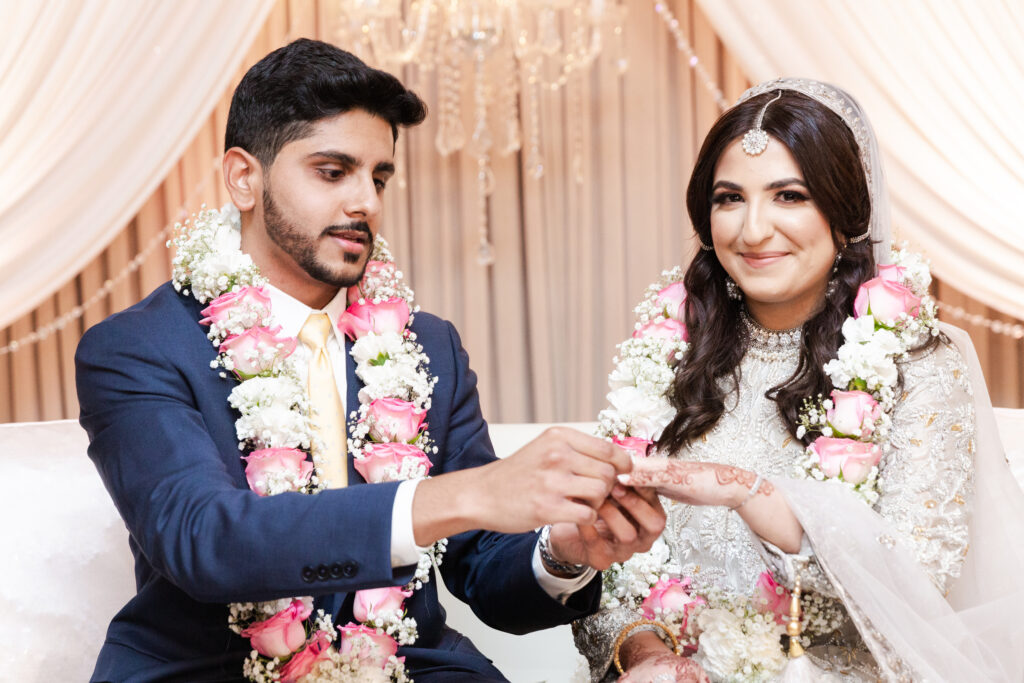
So, let’s talk about Baat Pakki—a significant step in Muslim weddings. Think of it as the moment things get official.
It’s like introducing your partner to the whole family, and everyone gives a thumbs-up.
Baat Pakki, often called a ‘done deal’, happens after the couple has met enough times to decide they want to have their families meet. The guy, the girl and their parents all decide when the couple will get engaged.
Punjabi’s call this custom ‘roka’, which means they’re stopping any other potential matches. Then, when the time is right, they have an official engagement ceremony.
During the Baat Pakki or Roka (the name of the ceremony may vary depending on the South Asian subculture), the groom’s immediate family will visit the bride’s house, talk about the engagement date and present sweets and gifts to the bride’s family.
In South Asian culture, the ‘Mangni’ or engagement is a significant pre-wedding event. It’s like the official announcement of a couple’s intention to tie the knot. Families gather, and the couple exchanges rings as a symbol of their commitment. Think of it as the exciting step before the big day. This tradition is all about celebrating the union, with both sides coming together to cement their bond.
In standard muslim wedding tradition, The ‘Mangni’ marks the beginning of the joyful journey towards marriage, a time when plans start to take shape, and the anticipation builds.
During this event, the immediate families and close relatives will gather for an intimate party either at bride’s home or a venue. At the engagement party, the couple enters separately, a small prayer will be made and the couple exchanges engagement rings. The parents will also adorn the couple with flower garlands and feed them mithais (milk based sweets) such as gulab jamuns and barfis.
A ‘Dua-e-Khair’ is a beautiful tradition within Muslim weddings. It’s a heartfelt prayer for the couple’s well-being and happiness, offered by the female elders and female guests. This meaningful gesture symbolizes blessings and good wishes for their future journey together. Picture it as a sincere moment when loved ones come together, their voices resonating with hopes and positivity. The ‘Dua-e-Khair’ adds a spiritual touch to the festivities, highlighting the importance of support and community in the couple’s new life.
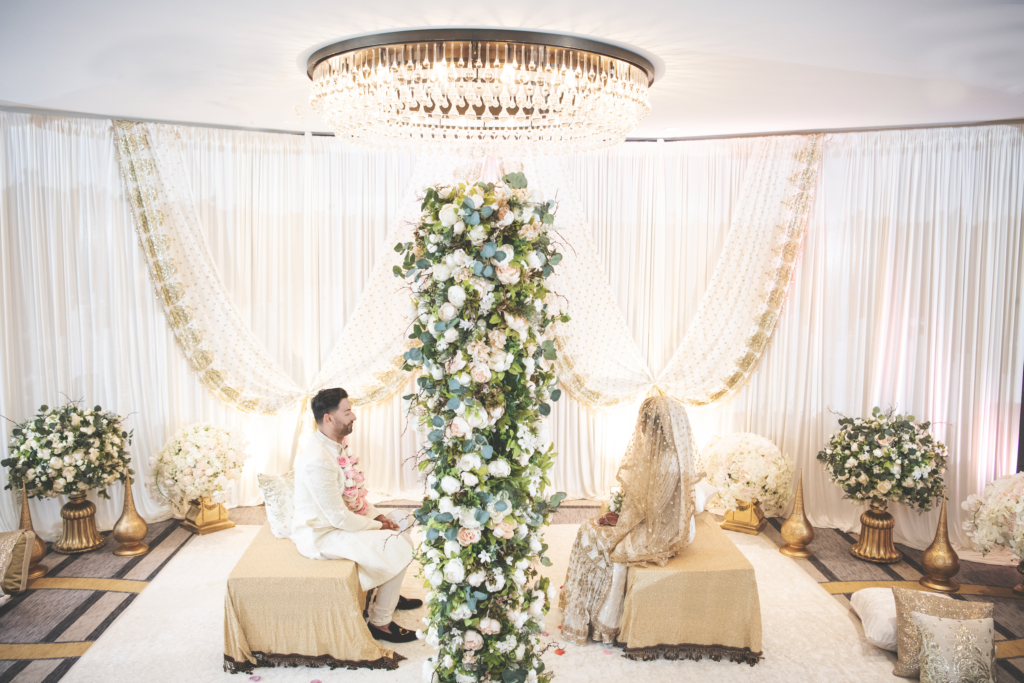
A ‘Nikkah’ stands as a pivotal moment within Muslim wedding tradition. It’s the official, binding marriage contract between the bride and groom, conducted in the presence of witnesses and an Islamic officiant.
Think of it as the heart of the celebration, where the couple openly and wholeheartedly makes their marriage commitment according to Islamic requirements.
The ‘Nikkah’ beautifully weaves religious and cultural significance, signifying the start of their shared journey. As voices recite sacred verses and blessings fill the air, you witness the couple’s union fortified by faith. It’s an intimate, yet profound declaration of love and devotion, uniting two souls in matrimony.
The Nikkah most commonly takes place at a mosque, the islamic place of worship on a Friday. Fridays are considered a very auspicious day for muslims and therefore a nikkah is usually set in the morning or late afternoon. Nikkah’s are never performed at night.

In South Asian culture, a ‘Maanja’ or ‘Dohlki’ is a vibrant pre-wedding festivity, adding color and joy to Muslim weddings. It’s a lively gathering where friends and family come together to celebrate the impending union.
Think of it as a musical and playful evening filled with traditional songs, rhythmic drum beats, and dancing. Both the bride and groom’s side hold this pre-wedding separately at their homes.
The ‘Mayoon’ ceremony, closely related, sometimes involves applying a turmeric paste on the bride and groom’s skin, symbolizing a radiant start to their marital journey similar to the Haldi ceremony celebrated in the Hindu wedding tradition. However, more often these days, instead of applying haldi (turmeric paste)
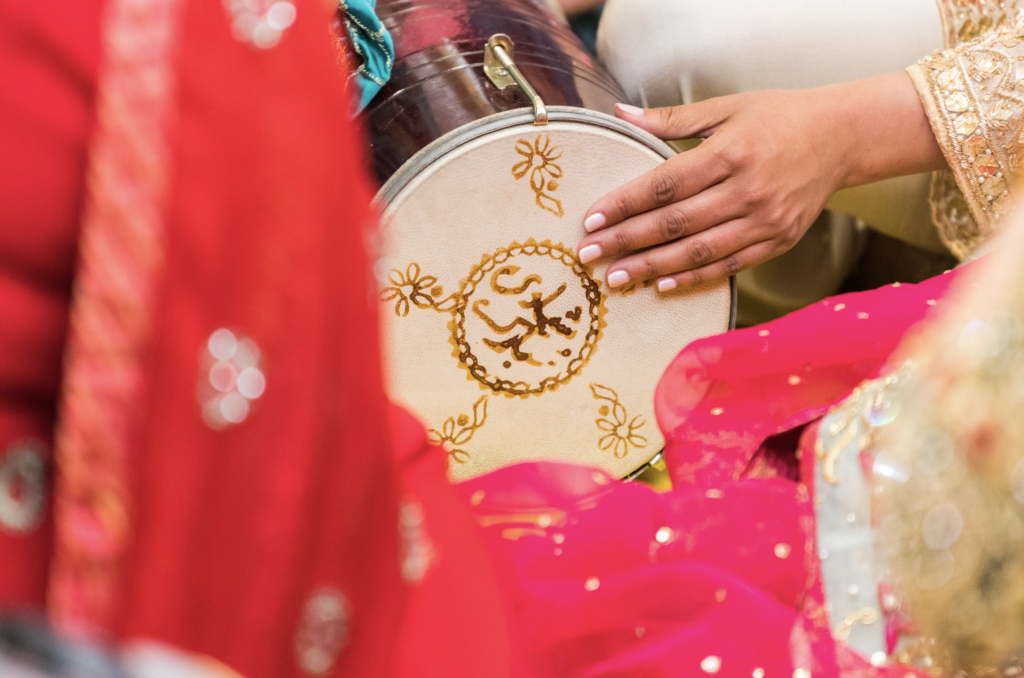
The Dohlki is yet another fun celebration for Pakistani and Indian weddings that involves more time connecting with relatives and friends while singing folk wedding songs, playing the dohl (hand drum) and eating delicious food like biryani, samosas, gulab jamun…It’s a feast of the eyes and belly! The Dohlki can be an informal event at home or at a venue. Families usually decide how much time and effort they want to put into the decorations. However, usually it’s a laid back event and the families have fun doing festive DYI decor on their own.
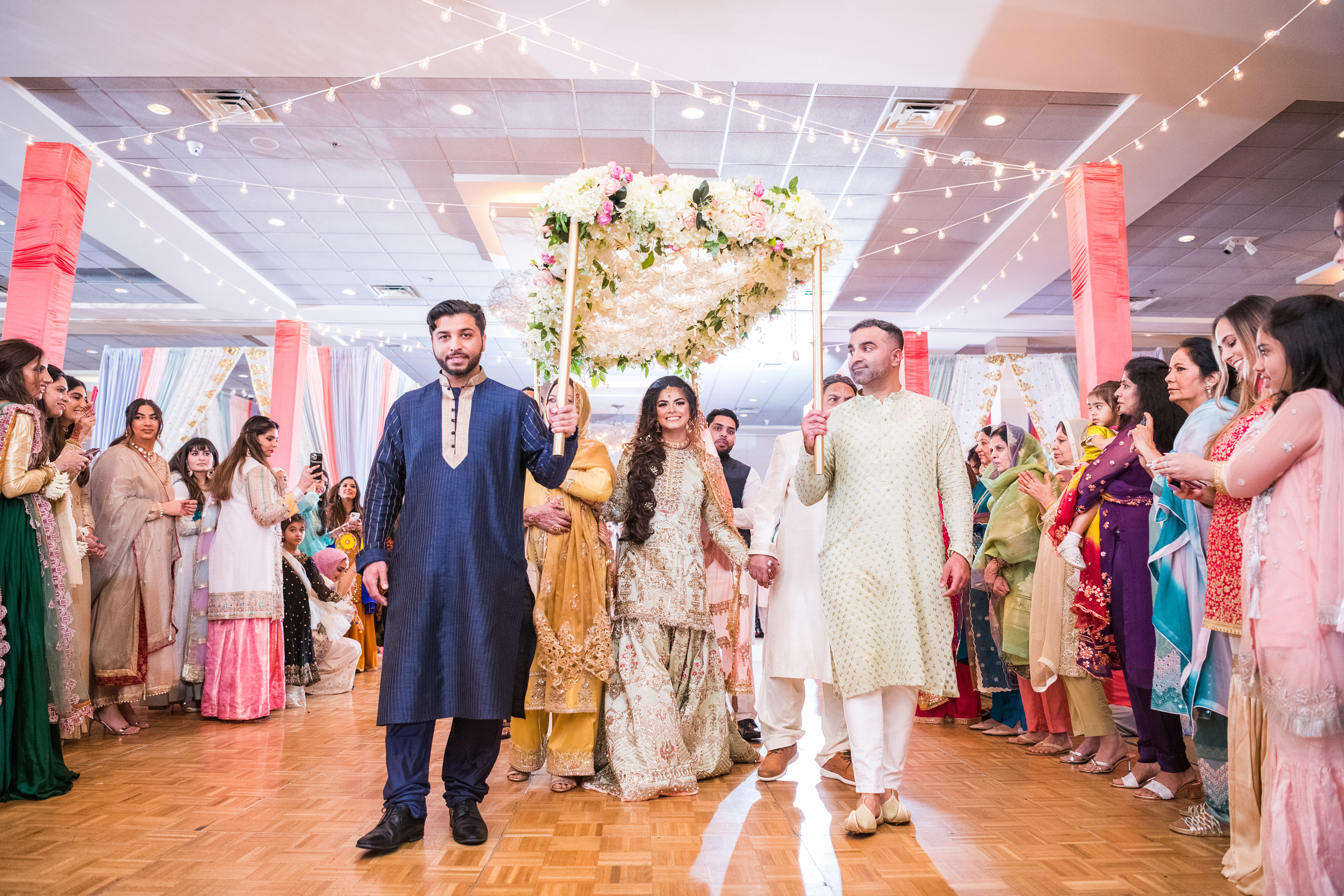
The ‘Mehndi’ or ‘Sangeet’ ceremony is a vibrant pre-wedding celebration that brims with joy and artistic flair. It’s a cherished tradition where family and friends come together to celebrate the upcoming wedding with music, dance, and intricate henna designs. The Mehndi ceremony is all about adorning the bride’s hands and feet with henna, symbolizing beauty, love, and the couple’s bond.
During the Mehndi party, the air is filled with melodies and rhythms as everyone participates in lively dance performances and musical acts. Although in conservative muslim families, they may avoid dancing and just focus on the mehndi rituals.
During the mehndi, you might see the immediate family perform quick rituals on stage with the couple. For example, feeding them sweets and putting a little henna on their hands. You will definitely see some playful pranks between the bride and groom’s side to extort money from the groom.
This festive occasion serves as a platform for both families to shower their blessings onto the couple. It’s a time for laughter, camaraderie, and friendly competitions between the bride’s and groom’s families.
The Mehndi celebration is not only a joyful festivity but also a poignant cultural expression, highlighting the importance of community and shared experiences that lead-up to a South Asian Muslim wedding. It’s a wonderful blend of creativity, music, dance, and heartfelt emotions that beautifully sets the stage for the upcoming nuptials.
Picture this: A South Asian or fusion wedding in full swing, with vibrant colors, melodious music, and a palpable sense of joy filling the air. Amidst the festivities, one of the most heartwarming moments unfurls as the bride’s family presents the Sanchak to the groom.
This exchange isn’t a mere formality; it’s a profound, emotion-laden gesture. As the bride’s family affectionately hands over the Sanchak, they convey their blessings for a happy and harmonious married life. It symbolizes their trust, support, and acceptance of the groom into their family circle.
For the groom, receiving the Sanchak holds immense significance. It signifies his commitment to shouldering the responsibilities and embracing the blessings that accompany his new role as a husband. This exchange isn’t merely physical; it establishes a spiritual and emotional connection with his bride’s family and cultural heritage.
In this Sanchak exchange, traditions come to life and are joyously celebrated. It’s a harmonious blend of the old and the new, a testament to the couple’s journey as they unite their cultural backgrounds. In modern fusion weddings, this tradition often takes on a unique twist.
Nowadays, couples integrate the Sanchak with the mehndi party to streamline the celebrations, reduce wedding expenses, and enhance practicality. This pragmatic approach doesn’t dilute the significance of the Sanchak; rather, it showcases the adaptability of traditions in contemporary time
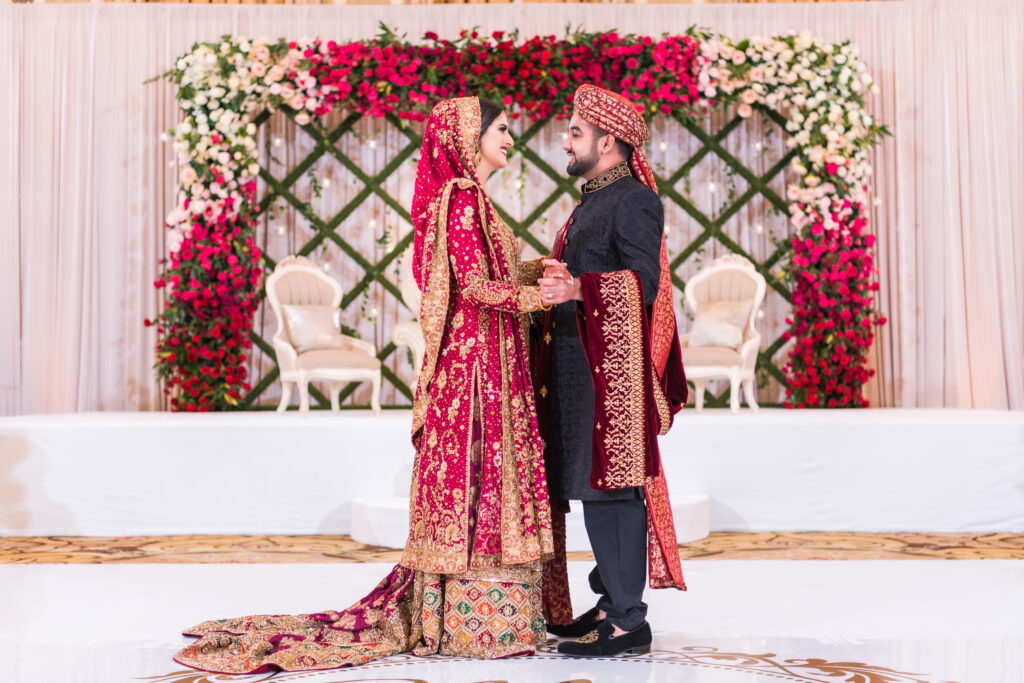
In South Asian muslim wedding tradition, a ‘Baraat’ is a jubilant and colorful procession that marks the groom’s arrival at the wedding venue.
It’s a spirited parade where the groom, accompanied by his family and friends, makes a grand entrance. Adorned in traditional attire, the groom rides a decorated horse or carriage, symbolizing his joyous journey into marriage. The Baraat is a sight to behold, full of music, dance, and exuberance, setting the stage for the celebratory atmosphere of the wedding.
Once the groom has made his entrance, the bride makes her entrance with her parents.
The bride usually wears a bridal dress called a lehenga in red.
Why red?
Because red is a very auspicious and celebratory color in South Asian culture.
The bride’s father gives the bride’s hand to the groom and the couple usually sit on the decorated wedding stage for a few additional customs.
These customs include: a short quran recitation, speeches, ring ceremony, garland ceremony and family photos. After dinner, the reception either flows into open dance or into the couple’s exit called the Rukhsati.
On the other hand, ‘Rukhsati’ is a bittersweet moment at the end of the wedding reception. It signifies the departure of the bride from her parental home to start her new life with the groom and his family. While it’s a heart-tugging farewell, it’s also a poignant symbol of the bride’s transition into her marital journey.
The Rukhsati is marked by emotional farewells, blessings, and well-wishes from her family. It’s a blend of mixed emotions, encompassing love, nostalgia, and hope for the future.
These two events encapsulate the emotional spectrum of a South Asian Muslim wedding – from the exuberant beginning of the Baraat to the tender farewell of the Rukhsati.
They showcase the cultural richness and emotional depth that make these ceremonies an integral part of the wedding narrative, creating lasting memories for the couple and their families.
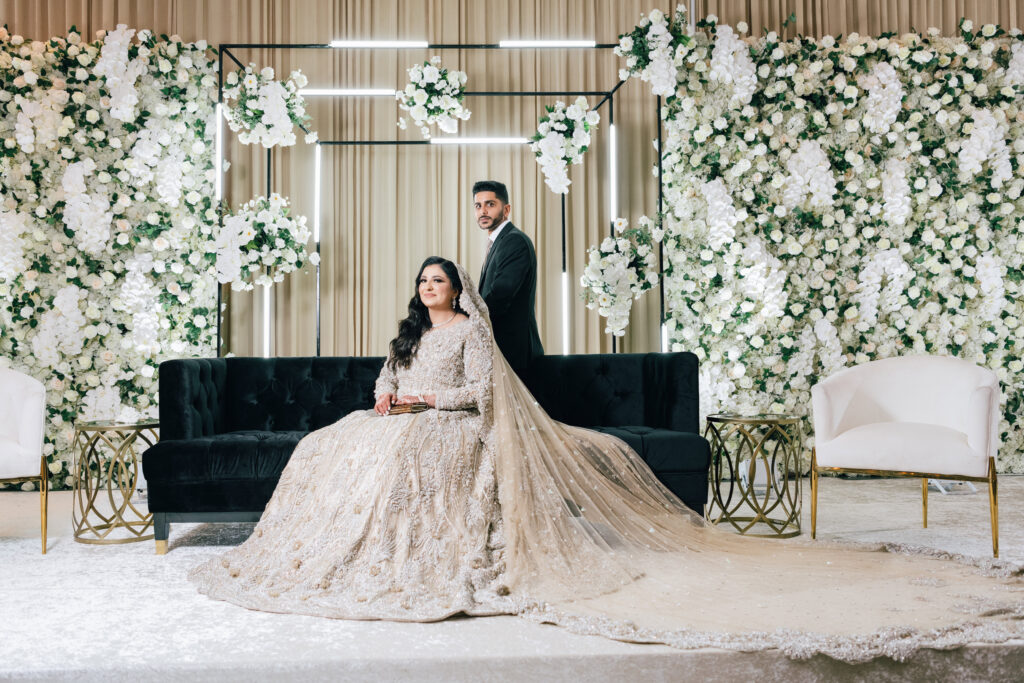
The ‘Valima’ ( alternatively spelled Walima, Walimah) is the crowning celebration of Muslim wedding traditions.
Hosted by the groom’s family, it’s a feast of unity and gratitude celebrating the newlyweds. Typically, the valima is more laid back event because it is like a second reception. For the valima, you will never see the bride wear a red lehenga. She will wear any color except red because red is usually worn on the wedding day.
The bride and groom, now officially newlyweds, bask in well-wishes from loved ones. At the valima, expect to see the entrances, short quran recitation, cake cutting, speeches, family photos and amazing food. At less conservative muslim weddings, there will probably be dancing.
The Valima bridges families, a harmonious blend of both sides. It’s a heartfelt culmination, offering hospitality and appreciation. Amidst genuine interactions, it symbolizes the start of a shared life.
In summary, the Muslim wedding traditions celebrated by Indian and Pakistani Muslims are a fascinating blend of culture, faith, family bonds and a touch of Bollywood magic. These rituals, steeped in history, hold a timeless charm that resonates with tradition and modernity.
From intricate mehndi designs to heartfelt vows, these muslim wedding traditions are not just ceremonies but bonding experiences, often infused with Bollywood-inspired glamour and filmy moments.
We hope you enjoyed taking this journey with us through the various Muslim marriage celebrations you will experience as a wedding guest!
Pinterest
Facebook
WhatsApp
Email
Subscribe to my weekly newsletter. I don’t send any spam email ever!